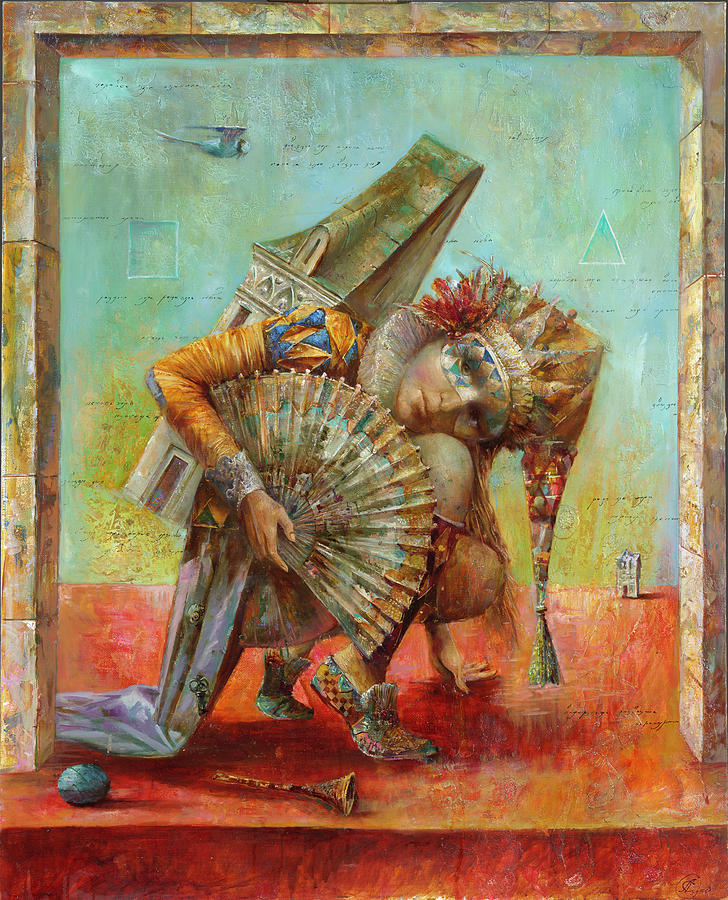Fata Morgana
Murmurs rise from silence
unnoticed by the ear.
Do I weep? or is that you . . . ?
A laugh
and then another . . .
Am I the doer
or the other?
Or are we duet,
both, together?
Murmurs hide in silence;
perhaps that is their home.

Fata Morgana -- Sergey Lukyanov
Murmurs rise from silence
unnoticed by the ear.
Do I weep? or is that you . . . ?
A laugh
and then another . . .
Am I the doer
or the other?
Or are we duet,
both, together?
Murmurs hide in silence;
perhaps that is their home.

Fata Morgana -- Sergey Lukyanov
"La Fata Morgana" ("The Fairy Morgana") is the Italian name of Morgan le Fay, king Arthur's enchantress 1/2-sister who was his mortal enemy. In her 1st literary appearance, the "Vita Merlini" of Gruffudd ap Arthur (Geoffrey of Monmouth) she and her 8 sisters were capable of shapeshifting and flying "like Daedalus, on strange wings;" Morgan was also described as a mathematician who taught astronomy to her sisters. After the battle at Camlann she took Arthur to die in Avalon, which was believed to be at the antipodes or Sicilia. Morgan was associated with the Sirens, who were believed to live near Sicilia, and with Sicilia at least since the 11th-century Normand conquest of southern Italia; for instance, the 13th-century "Floriant et Florete" identified her secret mountain castle as Mongibel (derived from the Arabic name for the volcano Etna), where she (the "mistress of the fairies of the salt sea") raised the orphaned son of a murdered Sicilian king. The Italians also added their own "Morgana" stories: Matteo Maria Boiardo's "Orlando innamorato" (1483-1495) her plot to destroy the world was foiled by Orlando. From these associations, she was credited with creating fairy castles in the air or false land to lure sailors to their deaths, as in particular kinds of mirages that are often seen in the Strait of Messina. The optical phenomenon occurs because rays of light are bent when they pass through air layers of different temperatures in a steep thermal inversion (an atmospheric condition where warmer air exists in a well-defined layer above a layer of significantly cooler air) where an atmospheric duct has formed, which acts like a refracting lens that produces a series of both inverted and erect images stacked on top of each other. A Fata Morgana may be seen on land or at sea, in polar regions or in deserts and may involve almost any kind of distant object such as boats, islands, or the coastline.A Fata Morgana is usually associated with something mysterious, something that never could be approached.
ReplyDeleteFATA MORGANA
O sweet illusions of song
That tempt me everywhere,
In the lonely fields, and the throng
Of the crowded thoroughfare!
I approach and ye vanish away,
I grasp you, and ye are gone;
But ever by night and by day,
The melody soundeth on.
As the weary traveler sees
In desert or prairie vast,
Blue lakes, overhung with trees
That a pleasant shadow cast;
Fair towns with turrets high,
And shining roofs of gold,
That vanish as he draws nigh,
Like mists together rolled—
So I wander and wander along,
And forever before me gleams
The shining city of song,
In the beautiful land of dreams.
But when I would enter the gate
Of that golden atmosphere,
It is gone, and I wonder and wait
For the vision to reappear.
-- Henry Wadsworth Longfellow